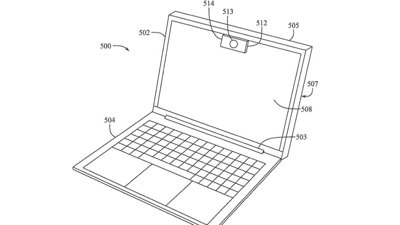Apple will announce as part of its special media event Tuesday a new family of MacBooks that will abandoned Intel's integrated graphics chipsets for those part of NVIDIA's new mobile platform, AppleInsider can confirm.
Word of the switch validates claims first published by AppleInsider earlier this summer, speficially that Apple would drop Intel's stock designs for the first time since the transition to x86 processors in 2006. At the time, Apple was understood to be making the switch to give Macs a more distinct and technically superior design compared to most other notebooks, whose size and performance are dictated by Intel's reference components.
Kept uncharacteristically secret by NVIDIA for most of the year, the MCP79 platform is so far considered a substitute for Intel's Centrino 2 "Montevina" platform, offering support for the same 1066MHz front side bus, optional DDR3 memory and PCI Express 2.0 interfaces.
Several advantages may tip the balance in favor of the new platform, however. From a physical design perspective, one of the most important factors is NVIDIA's consolidation of all the controller features into a single chip rather than the two necessary for Intel's current architecture. This reduces the total footprint needed for the mainboard in normally tight notebook enclosures.
It will also sport proprietary NVIDIA features such as DriveCache, which uses flash storage to speed up loading times, and Hybrid SLI, which switches from discrete to integrated graphics to increase battery life in low-demand situations. It's not known whether Apple will make use of any or all of these technologies, however.Â
The greatest leap, though, will come from NVIDIA's expertise in graphics.
MCP79 is believed to use a new set of GeForce 9300 and 9400 series integrated mainboard graphics processors. Regardless of which variant Apple uses, both are expected to support the latest visual effects and will theoretically blow past the performance of not just the Intel GMA X3100 video on Apple's current MacBooks but also the GMA 4500MHD found on newer notebooks using Intel's reference hardware.
While the performance may not compete with most dedicated mobile graphics hardware, the update potentially addresses a common complaint of sluggish video performance with Apple's 13-inch systems. These entry-level portables are often excluded from the requirements for certain demanding games and are even ruled out entirely from Apple's own Final Cut Studio 2 suite, which depends on faster video acceleration to drive visually intensive apps such as Color and Motion.
Moving to NVIDIA's higher quality integrated graphics would also line up with Apple's plans for Mac OS X Snow Leopard, the next-generation operating system aimed for release next summer. NVIDIA has already touted support for Apple's proposed OpenCL parallel computing standard, a feature of Snow Leopard, in its recent integrated graphics chipsets.
The use of NVIDIA's higher performance integrated video chipset would give Apple's new line of entry level MacBooks both improved general hardware acceleration via OpenCL, as well as making the systems more viable as basic gaming machines. Existing MacBooks can't even run the EA games Steve Jobs promoted at Macworld a year ago.
AppleInsider is working to confirm whether or not Apple's radical change in its portables' underpinnings will extend past the standard 13-inch models. However, it's believed Shrout may have valid insight into the directions for the MacBook Air and MacBook Pro as well. His claim would give the ultraportable model a low-voltage version of MCP79 that detunes the graphics performance and otherwise takes steps to reduce power consumption.
The MacBook Pro may actually see a relatively modest gain compared to the smaller systems; as it already uses much faster dedicated graphics and is rumored to receive the GeForce 9600M graphics chip.
Apple is expected to make the full extent of NVIDIA's role clear at its notebook event next week.
Separately, Digg founder Kevin Rose is claiming in a yet-to-be-shown live Diggnation episode that the new 13-inch MacBooks will include Blu-ray at some level. Rose previously claimed that Blu-ray support was coming via Mac OS X 10.5.6. Apple is a member of the Blu-ray Disc Association but has yet to officially support the optical drive format.
Again, additional expectations for the new notebooks can be found in a series of reports spanning back to April, when AppleInsider first reported on Apple's plans to makeover its MacBook and MacBook Pro families with new aluminum enclosures that take other designs cues from the MacBook Air and the most recent black & aluminum iMacs.
MacBook, MacBook Pro to get new aluminum designs (April)
Next-gen MacBook Pro casing design revealed, new battery cover (July)
New notebooks will include something other than Intel's Montevina chipset (July)
New MacBooks to follow iPods by several weeks; iMac bumps by mid-November (August)
New MacBooks tracking for mid-October timeframe (September)
First test batches of new MacBooks ship out of China (September)
Next-gen MacBook, MacBook Pro spotted in matching outfits (September)
New photo may reveal more of Apple's next-gen MacBook Pro (October)
Sources: latest MacBook Pro photo is the real deal (October)
 Kasper Jade & Aidan Malley
Kasper Jade & Aidan Malley






-m.jpg)






 Christine McKee
Christine McKee
 Andrew O'Hara
Andrew O'Hara
 Malcolm Owen
Malcolm Owen
 William Gallagher
William Gallagher

 Sponsored Content
Sponsored Content

 Mike Wuerthele
Mike Wuerthele







99 Comments
Fantastic news !!!!
They still use Intel processors though right?
Here's hoping this chipset doesn't end up with the same issues as NVIDIA has in the MacBook Pro models.
Sorry, I guess Im new to this. If they are moving to a NVIDIA chipset, is the chipset the processor? I didnt know NVIDIA made processors.